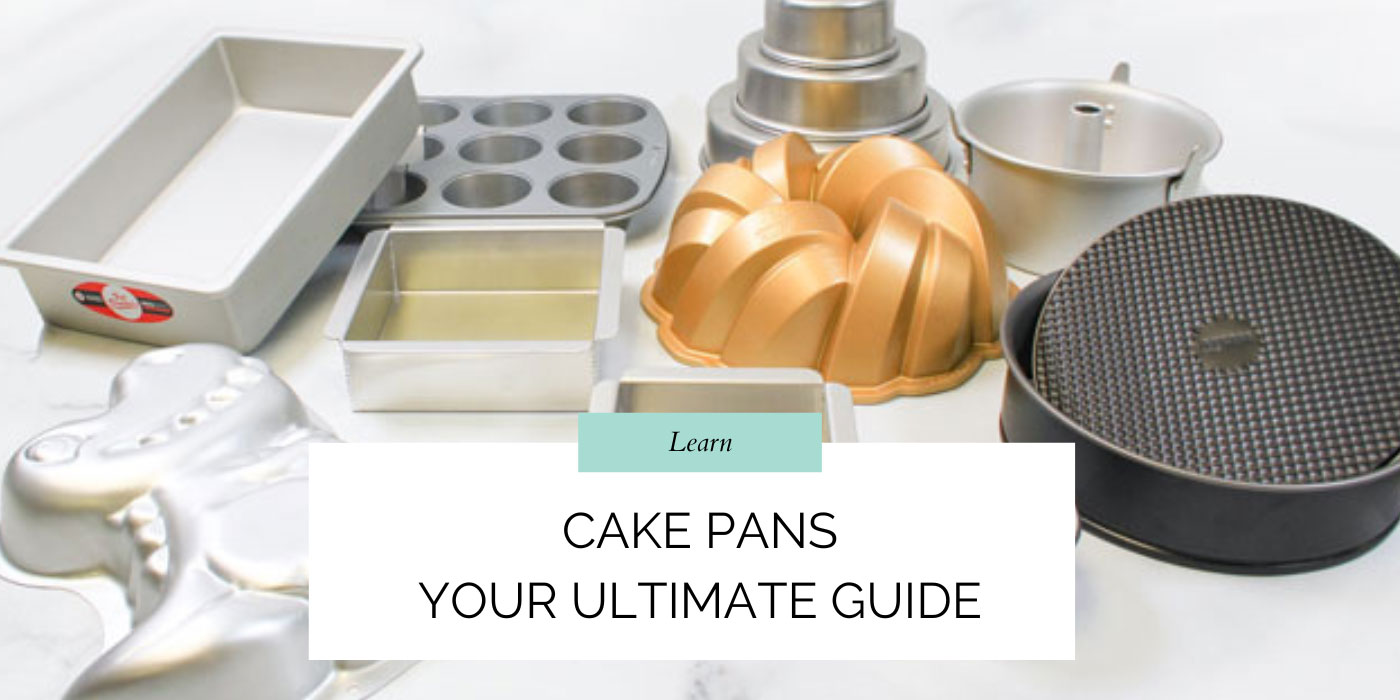
Cake pans are the foundation of every great cake. Whether you’re brand new to baking or you’ve been stacking tiers for years, choosing the right pan makes a big difference in how evenly your cakes bake, how easily they release, and how clean your edges look.
From classic rounds to detailed Bundt designs, this guide walks through cake pan features, types, materials, care tips, and how to pick the best pan for your next bake.
Cake Pan Features
When shopping for a cake pan, keep a few key features in mind to set yourself up for consistent, reliable results.
Material: Common options include metal, silicone, and glass. Material affects heat conductivity, browning, and durability.
Size: Match the pan size to your recipe. Too large = thin and dry. Too small = overflow risk and underbaked centers.
Shape: Choose a shape that fits your recipe and design: round, square, sheet, springform, Bundt, tube, or specialty shapes.
Durability: Look for pans that resist warping and hold up over time—especially for frequent bakers.
Price: Quality pans exist at many price points. Invest where it counts, especially in your most-used sizes.
Types of Cake Pans
Round Cake Pans

Round cake pans are the classic choice for layer cakes and tiered cakes. We carry sizes from 2" up to 16", so you can bake anything from a tiny top tier to a statement centerpiece. Straight sides and flat bottoms make them ideal for stacking and clean, sharp finishes.
Square Cake Pans

Square cake pans are great for layered cakes, cutting geometric shapes, or baking brownies and bars. Available in a wide range of sizes (4" to 20"), they’re versatile for both home bakers and professionals.
Sheet Cake Pans
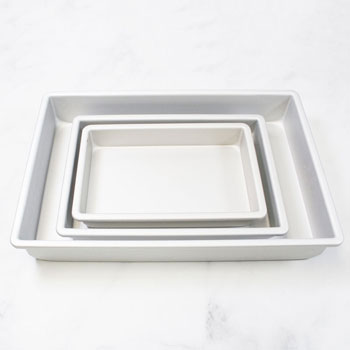
Sheet cake pans are perfect for party cakes, snack cakes, and large gatherings. The ever-popular 9" x 13" pan also doubles for casseroles, bars, and everyday baking.
Cheesecake & Springform Pans

Springform pans and removable-bottom pans are ideal for cheesecakes and delicate desserts. The collar releases cleanly, so you don’t have to flip your cake out of the pan—perfect for custardy or fragile bakes.
Bundt Cake Pans
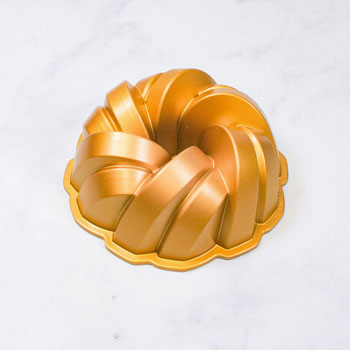
Bundt pans come in simple designs and intricate patterns that bake the decoration right in. They’re perfect for pound cakes and quick cakes, and also work for monkey bread, Jell-O, breakfast bakes, decorative ice rings, and more. For more ideas, visit our
Bundt cake inspiration gallery.
Tube Cake Pans

Tube pans (angel food cake pans) are made for airy batters like angel food, chiffon, and sponge. The center tube helps cakes rise tall and evenly, and many styles are ungreased and inverted to protect delicate structure.
Specialty Shape Cake Pans
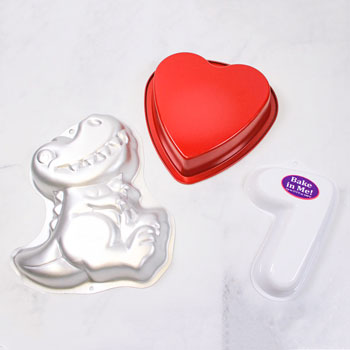
Novelty pans come in hearts, numbers, characters, seasonal shapes, and more. They’re perfect for themed parties and one-of-a-kind designs without carving.
Cupcake Pans

Cupcake pans (muffin pans) are essentials for cupcakes, muffins, mini cheesecakes, and bite-size desserts. Available in mini, standard, and jumbo cavities to match your bakes.
Cake Pan Materials
Cake pans are made from a range of materials. Each one bakes differently, so it helps to know what you’re working with.
Aluminum: Lightweight, affordable, and great heat conductor. Can react with acidic ingredients if not coated or anodized.
Anodized Aluminum: More durable, non-reactive surface, resists warping and metallic taste. A favorite for consistent results.
Stainless Steel: Extremely durable and non-reactive, but slower to heat. May require small adjustments to bake time.
Glass: Holds heat and can cause over-browning. Better suited for casseroles and slow bakes than cakes.
Cast Iron: Heavy-duty and heat-retentive; more niche for cakes due to longer heating time.
Silicone: Flexible and non-stick, fun for shaped bakes. Bakes more slowly and may not brown as evenly.
Non-Stick Coatings: Convenient release and easy cleanup. Avoid metal utensils to extend the life of the coating.
Insulated Metal: Designed for very even baking at precise temperatures; great for delicate cakes.
Ceramic: Pretty for baking-and-serve dishes, but slower to heat; better for cobblers and bakes than classic layer cakes.
Disposable: Foil pans are handy for gifting, events, and large batches. Best for convenience, not long-term use.
Whatever you choose, match the material to your recipe and watch your bake times the first time you try a new pan.
Baking in Dark Pans vs. Light Pans
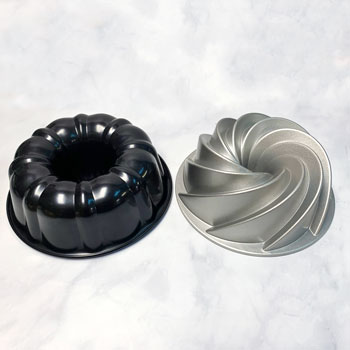
Light-colored pans (often aluminum) reflect more heat and are ideal for even baking without excess browning.
Dark-colored pans absorb more heat, which can speed up baking and deepen browning. They’re great for crunchy edges but may require lowering the oven temperature by 25°F or shortening the bake time.
Brands of Cake Pans
Quality matters. Here are some trusted brands we love and carry.
Fat Daddio's
Fat Daddio cake pans are made from anodized aluminum for excellent heat distribution, durability, and non-reactive performance—great for everyday and professional baking.
Wilton
Wilton bakeware offers a wide range of affordable pans, including springform, angel food, and shaped pans, with reliable performance for home bakers.
Nordic Ware
Nordic Ware is known for its iconic Bundt pans and detailed designs. Cast aluminum with non-stick interiors ensures sharp detail and easy release.
Magic Line
Magic Line pans feature heavy-duty aluminum, straight sides, and sharp corners—perfect for professional-looking layers and carved cakes.
Cake Pan Care
Proper care extends the life of your pans and keeps cakes releasing cleanly.
Gentle Cleaning: Use a soft cloth or sponge with warm water and mild dish soap. Avoid abrasive scrubbers.
No Harsh Chemicals: Skip bleach and strong chemicals that can damage surfaces or coatings.
Proper Storage: Store pans in a dry place. Nest carefully or separate with towels to prevent scratches.
Use the Right Tools: Use silicone, wood, or plastic utensils on non-stick surfaces. Avoid cutting directly in pans.
Greasing: Prepare pans as directed in your recipe. Our
premade pan grease
is a favorite for easy release and less scrubbing.
Are Cake Pans Dishwasher Safe?

Some pans are labeled dishwasher safe, but hand washing is usually best. Dishwashers can discolor aluminum, damage non-stick coatings, and shorten pan life. Always check manufacturer recommendations.
Conclusion
The right cake pan makes baking easier, more consistent, and a lot more fun. Think about what you love to bake—tall layered cakes, party sheet cakes, Bundt showstoppers, or themed designs—and choose pans that match your style, recipes, and oven.
Ready to size up your next celebration cake? Use our
cake chart
to find servings, batter amounts, and icing needs for round, square, and rectangular pans.